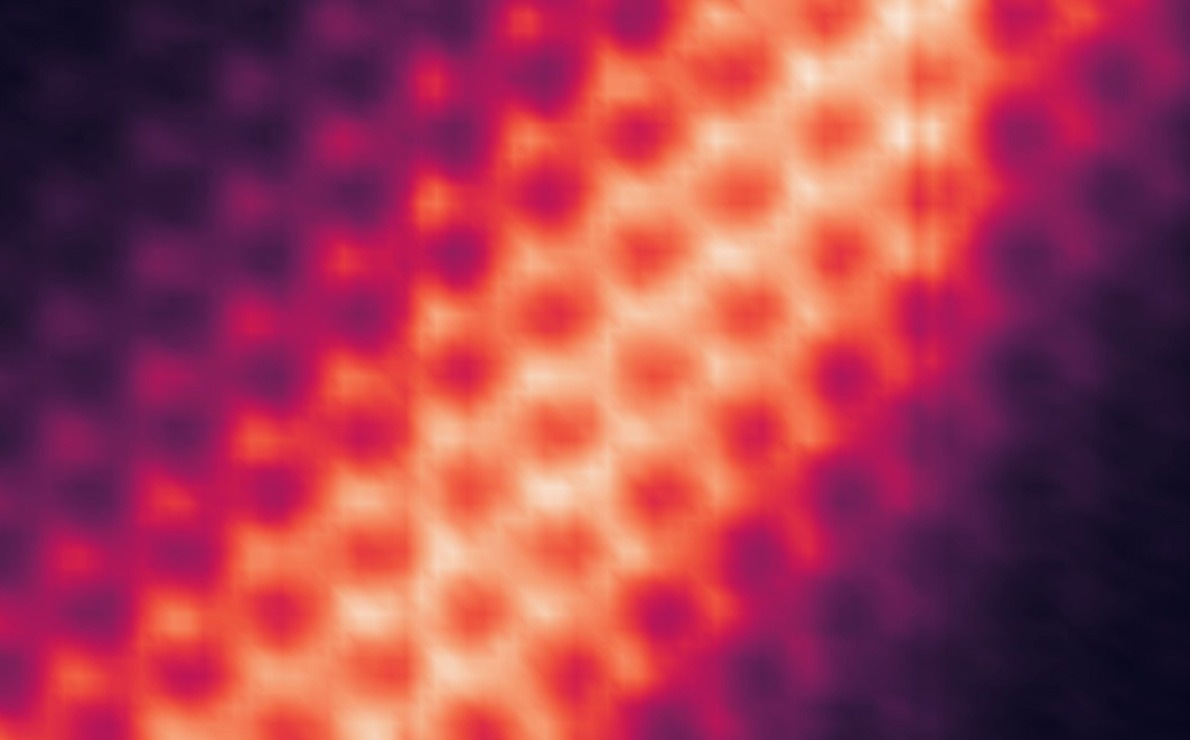Scientists have successfully electrically manipulated a 'chiral interface state' within a 2D material. This achievement holds significant promise for enhancing energy-efficient microelectronics and driving advancements in quantum computing.

STM image of a chiral interface state wavefunction (bright stripe) in a QAH insulator made from twisted monolayer-bilayer graphene in a 2D device. Image Credit: Canxun Zhang/Berkeley Lab
Under the direction of Lawrence Berkeley National Laboratory (Berkeley Lab), a global team of scientists has captured the first atomic-resolution photos and shown that electrical control can be applied to a chiral interface state, an unusual quantum phenomenon that may aid in the development of energy-efficient electronics and quantum computing.
The conducting channel, known as the chiral interface state, keeps electrons from being dispersed backward and producing energy-wasting electrical resistance by only allowing them to move in one direction. While chiral interface states in actual materials are of great interest to researchers, it has proven quite challenging to visualize their spatial characteristics.
However, a chiral interface state has now been directly observed for the first time, thanks to atomic-resolution photographs taken by a research team at Berkeley Lab and UC Berkeley. Additionally, the researchers showed how to create these resistance-free conducting channels in a 2D insulator on demand.
Their work is part of Berkeley Lab's larger effort to enhance quantum computing and other uses of quantum information systems, such as the creation and synthesis of quantum materials to meet urgent technological demands. The research was published in the journal Nature Physics.
Previous experiments have demonstrated that chiral interface states exist, but no one has ever visualized them with such high resolution. Our work shows for the first time what these 1D states look like at the atomic scale, including how we can alter them – and even create them.
Canxun Zhang, Study First Author, Department of Physics, University of California
Zhang is also a Former Graduate Student Researcher in Berkeley Lab’s Materials Sciences Division and is now a Postdoctoral Researcher at UC Santa Barbara.
Chiral interface states are a phenomenon observed in specific types of 2D materials referred to as quantum anomalous Hall (QAH) insulators. These materials exhibit insulating properties in bulk but demonstrate the unique ability to conduct electrons without resistance along one-dimensional "edges," which correspond to the physical boundaries of the material and interfaces with other materials.
In order to generate chiral interface states, the team collaborated at Berkeley Lab’s Molecular Foundry to produce a specialized device known as twisted monolayer-bilayer graphene. This device comprises two atomically thin layers of graphene meticulously rotated in relation to each other, resulting in a moiré superlattice that showcases the Quantum Anomalous Hall (QAH) effect.
Subsequent studies at the Department of Physics, UC Berkeley, employed a Scanning Tunneling Microscope (STM) to see the wavefunction of the chiral interface state by detecting various electronic states in the material.
Additional investigations demonstrated that by varying the voltage on a gate electrode positioned beneath the graphene layers, the chiral interface state could be shifted across the sample. In the last control demonstration, the scientists demonstrated how a voltage pulse applied to the tip of an STM probe could “write,” “erase,” and even “rewrite” a chiral interface state into the sample, where electrons flow in the opposite way.
The results could aid in the development of programmable electron channel networks, which could be useful for quantum computation exploiting the unusual electron behaviors in QAH insulators as well as energy-efficient microelectronics and low-power magnetic memory devices in the future.
Using their method, the researchers hope to investigate other unusual physics in related materials, like anyons, a novel kind of quasiparticle that may pave the way for quantum computing.
Our results provide information that was not possible before. There is still a long way to go, but this is a good first step.
Canxun Zhang, Study First Author, Department of Physics, University of California
Michael Crommie, a Physics Professor at UC Berkeley and a Senior Faculty Scientist in Berkeley Lab’s Materials Sciences Division, oversaw the project.
Tiancong Zhu, a Physics Professor at Purdue University, previously worked as a Postdoctoral Researcher in the Crommie group at Berkeley Lab and UC Berkeley. She contributed as a co-corresponding author.
Berkeley Lab’s Molecular Foundry is a DOE Office of Science user facility.
The Office of Science at DOE provided funds for this research. The National Science Foundation contributed additional funds.
Journal Reference:
Zhang, C., et al. (2024) Manipulation of chiral interface states in a moiré quantum anomalous Hall insulator. Nature Physics. doi.org/10.1038/s41567-024-02444-w.